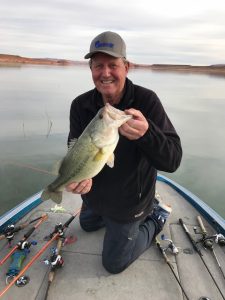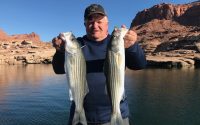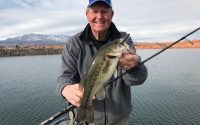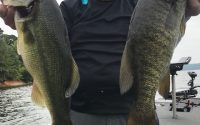Lake Powell Update

Lake Powell is a fantastic fishery and fall brings incredible opportunities with less fishing and boating pressure on the sprawling reservoir. After Labor Day, two things happen that improve the overall fishing. One, water levels generally drop which this year is an understatement. The reservoir is dropping nearly two feet a week which (when considering its size) is an amazing amount of water. Two, water temperatures are also dropping from the high to the lower 70s which converts to more active fish.
Considering those two factors, the bass (largemouth and smallmouth) are moving to vertical structure (points, bluffs, cliffs, and drop offs) and because it is fall, they will be looking for food. There is no question that the northern part of the reservoir has a better forage base than the southern end of the lake. Since I know the north better than the south, my suggestions will be for areas north of Iceberg Canyon (all the way to the Colorado River below Hite).
What Fish to Find
If you fish for bass, two types of areas should hold active, feeding fish. The mouths of bays, cuts, and points in the main lake collect fish as water levels drop. The bass will move out, set up, and ambush prey as schools of baitfish move past this vertical structure. The other areas that collect bass are the backs of coves. In the fall, coraling shad, blue gills, sunfish, or even small gamefish become top priorities for schools of bass looking for food. I’ve seen bass target large schools of baitfish and actually “trap” them in the backs coves for days before the baitfish figure out how to escape.
Walleyes also head to vertical structure as the water drops. I catch a lot of walleyes this time of year in 21 to 32 feet of water below drop offs or major points. They are a welcome surprise.
Stripers are a different kettle of fish. The all-out boils are so inconsistent now that you really can’t plan on them. However, I have found that the middle sections of coves and bays are great places to look for active fish. You must find them on your fish finder and then drop a spoon and try to activate the school. A white spoon (½ to ¾-ounce variety) dropped and brought up through the school will get them started. If that doesn’t work, just drop anchovies on a weighted hook to quickly activate the school.
Baits for bass are many and varied. Grubs, tubes, and drop shot worms (on vertical structure) are great baits this time of year. Stay with shades of green that will imitate small baitfish. Spinnerbaits, and shad-colored jigs work well too, but more so in the backs of coves. Blue Gill, sunfish, or shad-colored baits are generally the best for the next month or so.
I will be on Lake Powell later this week so in the next few weeks I will have additional information as to how well this fishery is progressing into fall.










